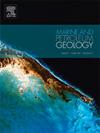Controls on storage capacity in mudstones. Cementation before sediment compaction and preservation of porosity in lithified rock
IF 3.7
2区 地球科学
Q1 GEOSCIENCES, MULTIDISCIPLINARY
引用次数: 0
Abstract
This contribution tackles the origin of porosity and cements in organic-rich mudstones, both important factors in the production of energy resources from unconventional reservoirs. A thorough chronology of sedimentary processes and early diagenesis depicts how most of the porosity (storage capacity) was preserved by 1) bottom current delivery of sand-size coccolith-rich pelagic fecal pellets to the seafloor, 2) limitation of pervasive early calcite cementation by reverse weathering, 3) cementation of pre-compaction microcrystalline quartz that stiffened the rock and limited the compactional porosity loss.
The presence and chronology of early cements, dissolution fabrics, and migrated oils indicate that significant volumes of fluid flowed through these sediment/rocks, and that fluid transport had a dramatic effect on the evolution of the pore filling histories because much of the cementation occurred prior to compaction. The preservation of porosity due to early cementation enabled subsequent flow of both aqueous and hydrocarbon fluids with consequential impacts on diagenesis and the ability of these mudstones to act as reservoir rather than seal facies.
The results emphasize that the prediction of facies in organic-rich mudstones should be based on pre-compaction diagenetic processes, which can significantly enhance or occlude porosity. In fact, facies in organic-rich mudstones are not satisfactorily predicted by the traditional methods that investigate solely environments of deposition and sequence stratigraphy.

控制泥岩的储存能力。沉积压实前的胶结作用和岩化岩石孔隙度的保存
这一成果解决了富有机质泥岩中孔隙度和胶结物的成因,这两个因素都是非常规储层能源生产的重要因素。沉积过程和早期成岩作用的全面年表描述了大部分孔隙度(存储容量)是如何被以下因素保存下来的:1)海底水流将砂大小的富含球石的上层粪便颗粒输送到海底;2)反风化作用限制了普遍存在的早期方解石胶结作用;3)预压实微晶石英胶结作用使岩石变硬,限制了压实孔隙度的损失。早期胶结物、溶解组构和运移油的存在和年代学表明,大量流体流过这些沉积物/岩石,流体运移对孔隙填充历史的演化具有显著影响,因为大部分胶结作用发生在压实作用之前。由于早期胶结作用,孔隙度得以保存,使得后续的水流体和烃流体得以流动,从而影响了成岩作用,也影响了这些泥岩作为储层而非封闭相的能力。结果强调富有机质泥岩相预测应以预压实成岩作用为基础,预压实成岩作用对孔隙度有明显的增强或遮挡作用。事实上,仅用沉积环境和层序地层学的传统方法预测富有机质泥岩的相不能令人满意。
本文章由计算机程序翻译,如有差异,请以英文原文为准。
求助全文
约1分钟内获得全文
求助全文
来源期刊

Marine and Petroleum Geology
地学-地球科学综合
CiteScore
8.80
自引率
14.30%
发文量
475
审稿时长
63 days
期刊介绍:
Marine and Petroleum Geology is the pre-eminent international forum for the exchange of multidisciplinary concepts, interpretations and techniques for all concerned with marine and petroleum geology in industry, government and academia. Rapid bimonthly publication allows early communications of papers or short communications to the geoscience community.
Marine and Petroleum Geology is essential reading for geologists, geophysicists and explorationists in industry, government and academia working in the following areas: marine geology; basin analysis and evaluation; organic geochemistry; reserve/resource estimation; seismic stratigraphy; thermal models of basic evolution; sedimentary geology; continental margins; geophysical interpretation; structural geology/tectonics; formation evaluation techniques; well logging.
 求助内容:
求助内容: 应助结果提醒方式:
应助结果提醒方式:


